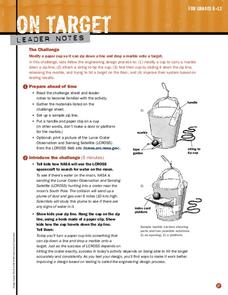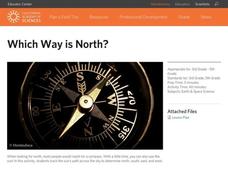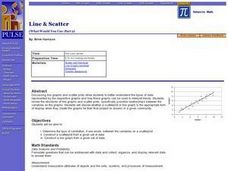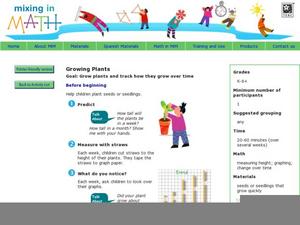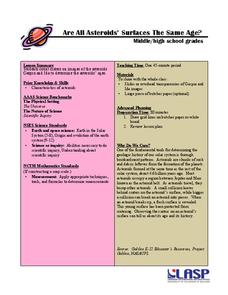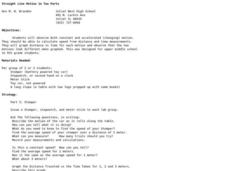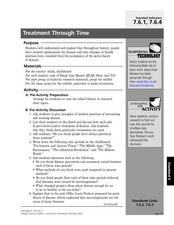Curated OER
Paper Production
Students compare paper making by hand and by assembly line. In this manufacturing instructional activity, students compare and contrast the two main ways to make paper, by hand or by machine. Students research paper making and have...
Space Awareness
Making A Sundial
Can people really measure time just by using the sun? Scholars venture outside on a nice, sunny day to build sundials and learn how people measured time 600 years ago. The class builds two different sundials while gaining practice with...
Curated OER
Yesterday, Today and Tomorrow--Measurements of Time
In this measurement of time worksheet, students read a short article and then look at 12 pictures and draw a line from each one to either the sun or the moon. Students distinguish whether each picture is happening in the day or in the...
Curriculum Corner
Guest Teacher Plans: Kindergarten
Emergencies happen. Be prepared the next time you have to call in a substitute with a lesson plan designed to meet the needs of a kindergarten class. Throughout the day, class members work with number and alphabet cards, identify numbers...
Curated OER
The Sundial of Space Exploration
In this science activity, students engage in the process of using a sundial to tell the time in various places. The sundial is meant to be cut out.
Curated OER
Sun and Shadows
Why do shadows look different in the summer than in the winter? What causes day and night? How can a sundial be used to tell time? Answer these questions and more through two engaging lessons about light and shadows. Fourth and fifth...
NASA
On Target
NASA's LCROSS mission is dropping a probe into a lunar crater. Groups design a system to travel down a zip line and drop a marble onto a target in the classroom. The groups then modify their designs based upon testing.
Mr. E. Science
Motion
An informative presentation covers motion, metric system, conversions, graphing of coordinates and lines, speed, velocity, and acceleration problems, as well as mean calculations. This is the first lesson in a 26-part series.
Curated OER
Slope of a Line
In this slope of a line worksheet, students read about line graphs and plotting the slope of a line. They read about the rate of change which is represented by the slope. Students practice finding the slope of lines.
DiscoverE
Air Train
Train your pupils to be master engineers. Young learners design a train that travels along a fishing line. The train needs to safely carry pennies as passengers without falling out.
California Academy of Science
Which Way is North?
Who needs a compass to find cardinal directions? Just place a stick in the ground and record the movement of its shadow over the course of a day. Then, measure the shadow lengths in order to determine a north-south line. A simple...
Wild BC
Greenhouse Gas Guzzlers
Teams of six to eight players imagine that they are driving in a vehicle and collect balls that represent carbon dioxide emissions based on their different activities. "Greenhouse Gas Guzzler" cards tell teams how many balls to collect...
Curated OER
Understanding Topographic Maps
Underclassmen create a cone-shaped landform and then draw a contour map for it. Then they examine a quadrangle (which was easily located with an online search), and relate it to what they experienced. The accompanying worksheet is...
Curated OER
Line & Scatter (What Would You Use: Part 2)
Learners discuss line graphs and scatter plots and the best situations in which to use them. Using the graphs, they determine the type of correlation between variables on a scatterplot. They create a scatterplot and line graph from a...
Curated OER
Martian Sun Times
Students become weather reporters for the Martian Sun Times newspaper to gather. interpret, and compare current weather information for Mas and Earth. Final articles be posted on-line. There are seven investigations in this unit.
Science Matters
Earthquakes and Volcanoes Pre-Assessment
See how much your class knows about earthquakes and volcanic activity and how these events shape geologic features. The first lesson in the series of 20 is a pre-test to find out what pupils already know. It includes 10 vocabulary...
Mixing In Math
Mixing in Math: Growing Plants
Whether you have your class plant seeds or begin when sprouts are visible, math skills are used here to predict and track growth over time. Straw bar graphs show plant height on a given day while the graph as a whole shows changes over...
DiscoverE
Let's Make an Elastic Puppet
Create bending joints—but don't break! The activity shows how to make a puppet using straws and fishing line. Pupils create cuts to make joints that rely on the elasticity of the straw to bend and return to their original shapes.
University of Colorado
Are All Asteroids' Surfaces the Same Age?
Did you know scientists can tell the age of an asteroid by looking closely at its craters? This final instructional activity of a six-part series focuses on two asteroids, Gaspra and Ida, in order to demonstrate the concept of dating...
Curated OER
Darwin's Principles
The author invested plenty of time in the presentation of this information; it is visually appealing, contains sound-effects, and displays creative animations and photos! Unfortunately, blank lines are included on most of the slides with...
DiscoverE
Let Your Lights Glow
Put those old holiday lights to good use. Individuals use a section of ornamental lights to create electric circuits. If the lights glow, it's a success; otherwise, it's time to try again!
Curated OER
Straight Line Motion in Two Parts
Students describe and quantify the motion of toy cars. In this motion lesson, students observe a battery powered toy car on a flat surface and a standard toy car on a sloped surface. They write their observations, measure average speeds,...
Curated OER
Treatment Through Time
Seventh graders explore how disease prevention and treatment changed throughout history. In this life science lesson plan, 7th graders create a classroom exhibit about this topic. They present their project to visitors.
Curated OER
A Matter of Timing
In this orbital period worksheet, students solve 2 problems about satellites and their orbits. They determine how many days it takes for two satellites to be in "opposition", they find the least common factor between their orbit periods...






